| Previous Chapter | Return to Thesis Homepage | Next Chapter |
3.1 The MIT Academic and Research Experience
3.2 The MIT Housing System
3.3 The MIT Campus Neighborhood
3.4 Food, Entertainment, and Retail Service
3.5 Transportation Service
CHAPTER 3. BACKGROUND INFORMATION ON THE MIT RESIDENTIAL EXPERIENCE
This chapter is intended to provide background information to help in understanding the features that shape the MIT residential experience. With some noted exceptions, the information in this chapter is based on my experience as a resident of the MIT campus for the past five years and an active participant in the planning and governance of the residential system. Individuals who live on the MIT campus or have extensive experience with it may not find a wealth of new information in this chapter. However, even people who are very familiar with the campus may learn a few new pieces of information or gain some new insights from viewing this information presented in a different way.
The topics covered in this chapter include the MIT academic and research experience, the MIT housing system, the characteristics of the neighborhood surrounding the MIT campus, the provision of food and retail amenities in the area, and the transportation system that serves the area. While there are many more features that might impact the residential experience, I have chosen these because I believe that understanding the residential experience is nearly impossible without some knowledge of these topics.
3.1 The MIT Academic and Research Experience
The Massachusetts Institute of Technology is an institution of higher learning that focuses on academics and research primarily in technological and scientific fields. According to ``MIT Facts'' for the 2002-2003 academic year, MIT has a faculty with 956 members, working in 5 academic schools (Architecture and Planning; Engineering; Humanities, Arts and Social Sciences; Management; Science) containing 21 academic departments and various other special academic programs. The undergraduate enrollment is 4,178, with 1,813 studying in the School of Engineering, 894 studying in the School of Science, and the rest distributed among the other schools. There are 6,139 graduate students enrolled in masters (2,694 students) and doctoral (3,265 students) degree programs as well as some other special programs. 2,763 graduate students work in the School of Engineering, 1,064 in the School of Science, 964 in the School of Management, and the rest distributed among other schools, including the Whitaker College of Health Sciences and Technology. (http://web.mit.edu/facts)
The undergraduate academic experience at MIT is a challenging one. It involves the completion of a core requirement of mathematical and scientific subjects, a required distribution of subjects in the humanities, arts, and social sciences, and a series of subjects specific to a major or ``course'' of studies. All freshmen typically take a similar program of core science subjects, from which a significant (though widely varying) percentage of students fail. MIT has a system of first-year grading in which a failing grade is counted as a ``no record'', that is to say, if a student fails, there is no record of the student having taken the course. Students may take required subjects multiple times before passing. Because freshmen are not awarded grades for their first-semester classes (only a ``pass'' or ``no record''), thus supporting a non-competitive atmosphere, and due to the difficulty of the subjects, students tend to work and study for core classes in groups. This group study supports students' academic work, but also has a social function. It is a way in which freshmen get to know each other, and provides opportunities for freshmen to interact with and learn from upperclass students.
At the end of the first year, undergraduates declare their ``course'' and fulfill a program of study in that course. All undergraduate Bachelor's degree programs are intended to last four years, though some students may take more or less time to complete their degrees. Most science and engineering subjects are taught within a format involving lectures, recitations, weekly or bi-weekly homework assignments known as ``problem sets'', and exams, while some subjects are more hands-on and focus on projects or laboratory work.
Research is also a part of the undergraduate experience. Most undergraduates participate in the Undergraduate Research Opportunities Program (UROP), in which part of their time (usually equivalent to the time dedicated to one academic subject) is spent working with a laboratory or research group for credit or for pay. Many undergraduates also do UROP work over the summer. As a result of this, along with the fact that many undergraduates find other types of summer work in the Boston area, a large percentage of undergraduates (the exact figure is probably between one-quarter and one-half) stay at MIT year-round.
Research constitutes a much larger part of the graduate student experience, particularly for doctoral students, as well as for postdoctoral fellows and most junior tenure-track faculty. The typical doctoral student at MIT has a research assistantship within one of a large number of laboratories and research groups on MIT's main campus as well as some satellite research facilities outside of Cambridge. These students spend large amounts of time on their research work, often working at odd hours such as late at night or on weekends, which is reflected in the colloquialism that MIT grad students ``live in lab''. Masters level students may have an experience somewhere between that of an undergraduate and that of a doctoral student, taking a few classes as well as pursuing some kind of research program. However, masters programs last only one or two years, much shorter than undergraduate or doctoral programs. As with undergraduates, many graduate students spend their summers at MIT continuing work on their research.
It is very difficult to characterize the MIT student ``lifestyle'' because it varies widely from person to person. However, general impressions seem to indicate that the typical MIT student, along with many faculty, lives a very busy lifestyle. Most of a student's time is dedicated to academic or research work. Students tend to make time for athletics and other extracurricular activities, but this leaves very little unstructured ``free time''. Finding time for eating and sleeping can sometimes be a challenge. Altogether, the weekday schedule of a typical student tends to be fully occupied by classes, lab work, extracurricular activities, group study sessions, and perhaps some brief social activities, while weekends may involve some social outings or parties mixed with study and lab work.
The MIT campus provides a range of housing options to its undergraduate and graduate students. Figure 3-1 in Appendix A supplements the information in this section by showing the geographic locations of different MIT residential facilities around its Cambridge campus.

Download printable image (PDF 476K)
The MIT undergraduate housing system consists of eleven separate dormitories with a combined occupancy of 2,929 (according to the MIT Housing Office Website, http://web.mit.edu/housing). The dormitories range in occupancy from 93 students to 362. Most dormitories house men and women, the exception being McCormick Hall which is all female. All dormitories house students from all four class years in roughly equal proportions. Before their freshman year, students enter a lottery indicating what dormitory they would like to live in, and typically stay in that dormitory for all four years. Housing policy guarantees that undergraduates may receive four years of housing in dormitories.
There is one special residential model at MIT known as the ``cultural house''. Cultural houses are living groups in which residents share a common theme relating to a national or ethnic culture. There are currently five cultural houses at MIT, all housed within a section of the New House dormitory. The cultural houses vary in size, with somewhere around twenty members being typical.
In addition to its undergraduate residents, undergraduate dormitories house Graduate Resident Tutors (GRTs), graduate students who serve as a support resource for undergraduates. There is one GRT for about every 30-60 undergraduates in the system, so about 60-70 GRTs altogether.
Complementing the MIT-operated housing system is a system of MIT-recognized but independently-operated fraternities, sororities, and independent living groups (FSILGs) that offer housing to MIT students. FSILGs mainly house undergraduate students, though some graduate students may live there as well (typically former undergraduates). The system includes twenty-five residential all-male fraternities, four residential sororities, one all-female cooperative independent living group, and six residences that are considered either co-ed residential fraternities or co-ed independent living groups. FSILGs range in size, each housing roughly 20 to 50 students. Ten of these are located in Cambridge, two are located in Brookline, and the majority are located in the Back Bay area of Boston directly across the Charles River from MIT. Before 2002, MIT students at the beginning of their freshman year engaged in a ``rush'', a four-day period in which they explored residences and decided whether to pursue joining an FSILG or to enter preferences in the MIT dormitory housing lottery. As with dormitories, students joining an FSILG would typically stay there for four years. Before MIT recently enacted its policy of housing all freshmen in dormitories, almost one-third of all undergraduates and one-half of undergraduate men lived in the FSILG system. However, this number has fallen due to the new policy, and in the future there will surely be changes in the size and character of the FSILG system.
The single graduate housing system consists of six residences. Green Hall is designated only for women graduate students, Tang Hall and the Warehouse are designated only for first-year graduate students, and the rest house men and women of all years. While Green Hall and Ashdown House are dormitory-style residences, the other residences are arranged as apartments or suites. For students with families, there are about 200 apartment units available at Eastgate and Westgate.
The housing policy for graduate students is designed to allow all first-year students who desire on-campus housing to receive it, but also to accommodate as many continuing graduate students as possible. The demand for graduate housing typically far outpaces the supply. The single graduate housing system has a capacity to house only about 1,820 single students and 400 students with families (which may contain more than 400 students, since there could be more than one student in a family). Further complicating the undersupply of graduate student housing is MIT's new policy of allowing about 150 undergraduates, mostly seniors but also some undergraduate sorority members, to live in graduate housing. This is to ensure that MIT can uphold its policy of providing four years of housing to all undergraduates who request it.
Residences at MIT play a primary role as social groups on campus, as reflected in Chapter 2 by the description of the social role of the fraternity system and the dormitory ``house system'' that evolved from it. Undergraduate residences in particular serve as centers for group study and social activity, and students tend to identify strongly with their residential group. Figure 3-2 in Appendix A charts some results of a survey of seniors conducted by the MIT Office of Institutional Research. These charts show that MIT undergraduates, particularly in the FSILG system but in the dormitory system as well, identify a strong sense of community existing within their living group. However, they indicate a much weaker sense of community across the campus at large.
Figure 3-2 currently unavailable
The program of social activities in residences is largely student-run. In the FSILGs, students manage all aspects of operation including the social program. In MIT dormitories, elected student governments raise a ``house tax'' from residents to fund social activities and common resources for students. This has been true of undergraduate residences for decades, and has been developing more recently within the graduate residential system. As of the 2002-2003 academic year, every graduate dormitory (including Eastgate and Westgate) has a student government that runs its own social program.
MIT does not own or operate residences specifically for faculty and staff. However, each student residence, with the exception of Edgerton, Eastgate and Westgate, contains one or two apartments for housemasters and their families. Housemasters are faculty or senior staff who have broad responsibilities for overseeing the social and educational well-being of the individual students and the student communities within residences. Altogether, there are about 20 housemasters and their families living within the MIT housing system. In addition, Eastgate accommodates a small number of faculty and their families.
Also within the area of the MIT campus, on MIT-owned land, is a 270-unit private apartment building at 100 Memorial Drive. While this facility is neither owned nor operated by MIT, the owners maintain an agreement that MIT affiliates receive first priority in leasing vacant apartments. Therefore 100 Memorial Drive houses a large concentration of MIT faculty, staff and students.
3.3 The MIT Campus Neighborhood
The present MIT campus was built on land that was claimed from the Charles River Basin in the late 19th century. This land lay directly to the south of a rail line that was established in the 1860s. During the age of industrial expansion between the late 19th century and early 20th century, this rail line fueled the development of a high concentration of factories in this part of Cambridge and the development of multi-family housing units nearby. Thus the area had been established as an ``industrial neighborhood'' as the MIT campus was beginning its development in Cambridge.
In the latter half of the 20th century, older factories began to close or move into suburban areas where larger land parcels were available. While much of the land around MIT lay vacant from about the 1960s to the 1980s, in the past twenty to thirty years this land has been redeveloped for private or government office and laboratory uses, typically for companies in high-technology fields. Currently, the area around MIT is beginning to establish itself as a center for life sciences research and biotechnology, and land in the area has become very valuable to developers who can build the specialized laboratory facilities to accommodate these companies' needs. However, some new development in the area has been for other uses as well, including housing, hotels, retail, and entertainment uses. Figure 3-3 provides a rough picture of the distribution of different land uses around the area of the MIT campus.
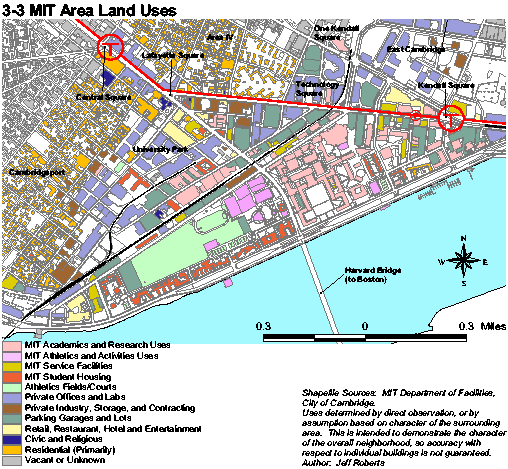
Download printable image (PDF 516K)
Residential neighborhoods begin to re-emerge outside the ``belt'' of industrial and research uses north of the MIT campus. The neighborhoods surrounding MIT include Cambridgeport to the northwest, Area 4 and Wellington-Harrington to the north, and East Cambridge to the northeast. These neighborhoods are historically mixed-income and contain a large number of multi-family housing units. In addition, south of the MIT campus, across the Charles River via the Harvard Bridge, is the Back Bay neighborhood of Boston, an upscale residential area with many restaurant, retail, entertainment, and civic amenities.
Many students who do not live within the immediate MIT campus area find housing in these residential neighborhoods to the north and south. Figure 3-4 in Appendix A displays some information about the residential nature of the area as it relates to students. The ``core area'' of the MIT campus, three US Census Tract areas in Cambridge containing MIT campus buildings, private industrial, office, and laboratory buildings, and the southern ``fringes'' of the Cambridge residential neighborhoods, is not a very dense residential area though it contains a very large proportion of the MIT student body. Due to its relative affordability and proximity to campus, the residential ``belt'' surrounding the campus ``core'', including the Central Square area, East Cambridge, and Cambridgeport, is home to a significant proportion of MIT graduate students (and, presumably, some number of Harvard University graduate students as well). The section of Boston's Back Bay within about a mile walking distance of the center of the MIT campus contains a large number of undergraduate students, mostly members of FSILGs, along with some graduate students.
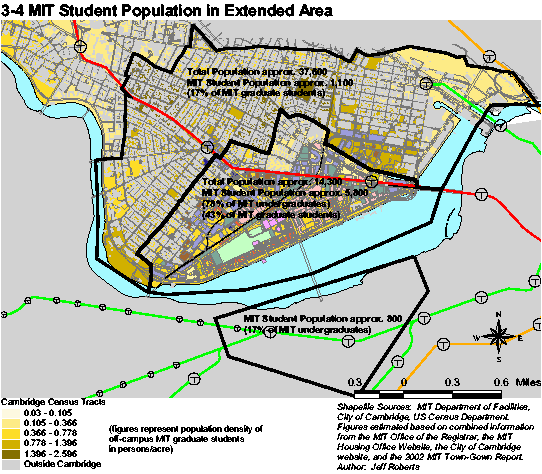
Download printable image (PDF 731K)
3.4 Food, Entertainment, and Retail Service
The MIT campus area provides food to campus residents in a number of different ways. Figure 3-5 in Appendix A shows the locations of different types of food providers in the area.
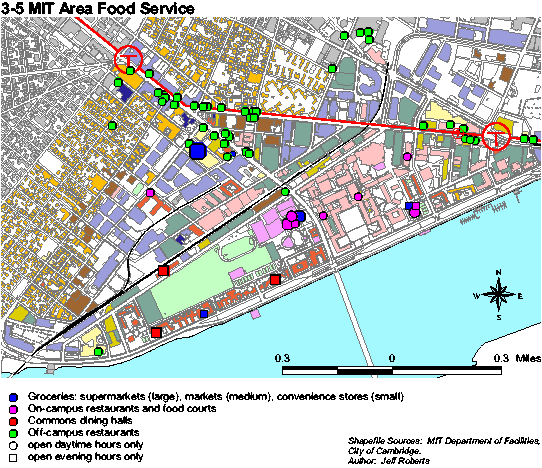
Download printable image (PDF 547K)
The MIT-operated campus dining system consists of a few different elements. There are several dining halls, cafes, and food courts distributed around the main campus that provide daytime food options (breakfast and lunch) to students, faculty, and staff working on campus. During evening hours, the client base for campus dining consists primarily of students. There are two evening-hour restaurants located in the Student Center and one in Walker Memorial, as well as commons dining halls in three undergraduate residences that provide dinner as well as some late-night food service. There is also a restaurant located within the Sidney-Pacific graduate residence that is open every day in the morning, afternoon and evening.
The major provider of groceries in the area is Star Market, a supermarket, located in University Park. There are other specialty supermarkets within nearby parts of Cambridge, but most require a car for convenient access. A smaller, independently-run market is located within the Student Center, and even smaller convenience stores operated by MIT dining services are located in Walker Memorial and MacGregor House. There are also some smaller private markets in the area that provide convenience goods or specialty (primarily ethnic) foods.
There are some private restaurants in the area, mainly concentrated around activity centers such as Kendall Square, Lafayette Square, and Central Square. Restaurants around Kendall Square, along with some restaurants located closer to MIT, tend to be oriented towards providing breakfast and lunch to area workers, and therefore many tend not to be open in the evenings or on weekends. Restaurants in Lafayette Square and Central Square, which are closer to residential neighborhoods, tend to be open in the afternoons and evenings, and many of these restaurants provide a delivery service as well. For entertainment, the area has several bars as well as some nightclubs and music venues that are mainly located along Massachusetts Avenue between Lafayette Square and Central Square. There is also a unique center of restaurant and entertainment activity in the area known as ``One Kendall Square'', an office and laboratory complex to the northeast of campus which contains a small cluster of restaurants and bars as well as a multiplex movie theater that shows independent and foreign films.
The nearest true shopping center to the MIT campus is the Cambridgeside Galleria, a shopping mall, which is located about a ten-minute walk away from Kendall Square in East Cambridge. This mall contains a diverse selection of small retail stores and department stores. There are also some retail stores in the area along Massachusetts Avenue north of Lafayette Square, particularly around Central Square. These include drug stores, hardware stores, video rental stores, bookstores, and some clothing stores. There are also some retail stores in Kendall Square, including a drugstore, a florist, and a few others. Kendall Square also contains bookstores, specifically the Harvard/MIT Cooperative Society (the official MIT bookstore) and Quantum Books, which provide textbooks for MIT classes.
Walking routes are the most commonly-used mode of transportation to and from destinations within the campus environment. Figure 3-6 in Appendix A indicates what buildings are within particular walking radii of the ``center'' of the MIT campus using official sidewalks and walkways. I am defining the "center" to be the main entrance at 77 Massachusetts Avenue, the point between the eastern and western halves of campus, not the center of MIT's main academic facility which would lie further to the east. While most campus uses are located within a ten-minute walking radius from the campus center, this implies a walking time of twenty minutes or more to travel from one end of campus to the other (for instance, from the Tang residence hall on west campus to the Tang Center for Management Education on the Sloan School area of campus). So while walking is the most popular means of transportation, one finds that many students living outside the five-minute radius from the center prefer to use bicycles to commute to and from the academic side of campus. An additional factor complicating pedestrian transportation is the CSX railroad line, an at-grade rail which can only be crossed at certain designated points.
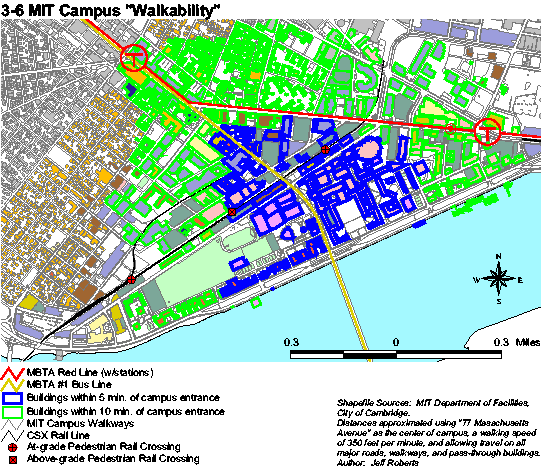
Download printable image (PDF 610K)
MIT also offers two free shuttle services to help move individuals across the campus. The Tech Shuttle runs during work hours on weekdays, and its purpose is to provide a faster means of traveling from Kendall Square to the extreme western end of the campus while also stopping at 77 Massachusetts Avenue. The SafeRide shuttle runs every day during nighttime hours, from 5PM to 3AM or 4AM, and its purpose is to move individuals safely from 77 Massachusetts Avenue to their homes at night. The SafeRide system serves parts of Cambridge as well as Boston. In addition to the MIT-operated shuttles, MIT students living in Cambridgeport can take the EZRide shuttle, a private shuttle service that connects the University Park area to North Station in Boston via Kendall Square. This shuttle operates on weekdays during rush hours, and students living in Cambridgeport may use it to travel to the eastern side of campus on weekday mornings.
Since most residents of the campus walk to everyday destinations, they tend to use public transportation to travel around the region at large. Rapid transit service to and from the campus is provided by the MBTA Red Line subway, which has stations at Kendall Square and Central Square and connects the campus directly to Harvard Square to the north and downtown Boston to the south (and thence to the larger regional MBTA system). Figure 3-7 in Appendix A shows what buildings are located within particular catchment radii of Red Line stations, and indicates that many MIT residences are located outside the ten-minute catchment area of either station.
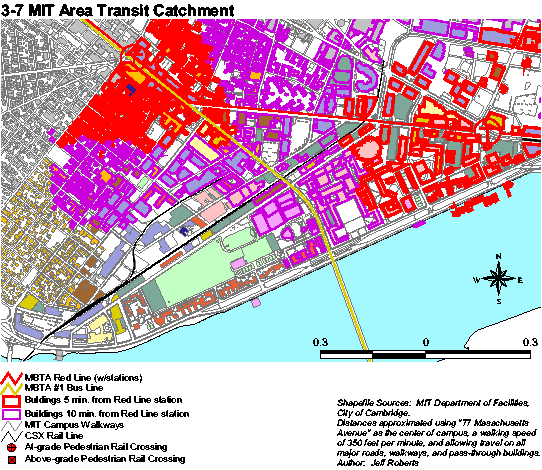
Download printable image (PDF 639K)
Some other regional public transportation options are available besides the Red Line. The ``Number 1'' bus line, which travels along Massachusetts Avenue between Harvard Square in Cambridge and Dudley Square in Roxbury, has a stop at 77 Massachusetts Avenue. Many residents living on the west side of campus use this bus to travel to Harvard Square or to cross the Harvard Bridge into Boston. After crossing the bridge by walking or using the Number 1 bus, residents can use the Green Line to travel to western parts of Boston or into downtown. Additionally, two limited-stop ``crosstown'' bus lines, the CT1 and CT2, serve the MIT area. The CT1 follows Massachusetts Avenue into Boston, and the CT2 runs along Vassar Street, connecting MIT to the Fenway area to the west and to Somerville and Charlestown to the east. However, these lines are intended primarily for commuters, and so they only operate in the daytime on weekdays.
| Previous Chapter | Return to Thesis Homepage | Next Chapter |
CONTENTS
3.1 The MIT Academic and Research Experience
3.2 The MIT Housing System
3.3 The MIT Campus Neighborhood
3.4 Food, Entertainment, and Retail Service
3.5 Transportation Service
Copyright MMIII Jeffrey C. Roberts. All rights reserved.
contact: jeffroberts@mit.edu